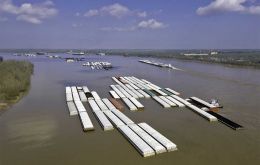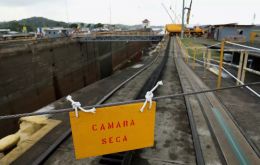MercoPress. South Atlantic News Agency
Tag: drought
-
Monday, September 2nd 2024 - 07:44 UTC
Drought in Brazil reaching unprecedented limits

According to Brazil's National Center for the Monitoring of Natural Disasters (Cemaden), South America's largest country is facing the most severe drought in its recent history. The agency also noted that more than one third of the country was affected by “extreme drought.”
-
Tuesday, April 16th 2024 - 10:26 UTC
Gradual improvement reported at Panama Canal

Things are looking up for the drought-stricken Panama Canal as new water levels allow an increase in the daily number of ships allowed through the man-made interoceanic corridor. Starting in June, 32 ships will be let through, it was announced Monday.
-
Thursday, January 4th 2024 - 10:32 UTC
Uruguay: Agriculture emergency lifted except for fruits and horticulture

Uruguayan authorities Wednesday declared the end of the agricultural emergency adopted in October 2022 to address the water deficit the country was going through, it was reported in Montevideo. The measure was extended several times to support those producers most affected by the climate situation.
-
Wednesday, December 27th 2023 - 10:29 UTC
Lowest rainfall in over 40 years affects Amazon basin rivers

A recent study from the European Union Science Center showed that rivers in the Amazon basin have been severely affected by historic poor rainfalls, Agencia Brasil reported. The region's biodiversity has also been hit by the meteorological conditions, particularly in the headwaters of the Solimões, Purus, Juruá, and Madeira rivers (Brazil's Amazonas state) and also in parts of Peruvian and Bolivian forests.
-
Wednesday, November 29th 2023 - 14:19 UTC
US grain exports threatened by insufficient draft along the Mississippi for barges

As has happened with the mighty Paraná River in the heartland of South America, with the Amazon in northern South America, and even with the Panama Canal, all of them suffering lack of rainfall to keep basins flowing with sufficient water levels, now has come the turn of the Mississippi with insufficient draft for the vessels and barges involved in transporting US grains.
-
Saturday, November 18th 2023 - 10:30 UTC
Argentine government and consultants anticipate a great 2023/24 agricultural year

Under pressure from the Argentine incumbent presidential candidate for this Sunday's election runoff, and current Economy minister, Sergio Massa, grain markets in the country are forecasting a promising boom for the next agriculture year, with recovered crops and increased revenue to the tune of some US$ 20bn.
-
Tuesday, November 7th 2023 - 09:52 UTC
Panama Canal drought emergency, ships booking slots cut to 25 per day and to 18 next February

Following on the driest October since at least 1950, the Panama Canal Authority has said it has been forced to cut the number of ships using the waterway. This will naturally have an impact on the cost of shipping goods across the world.
-
Monday, October 30th 2023 - 09:20 UTC
Colombia to supply electricity to Ecuador to solve energy crisis

In a move to solve the current energy crisis affecting some Ecuadorian towns, Ecuadorian President Guillermo Lasso announced on X after a meeting Saturday with Gustavo Petro at the Casa de Nariño in Bogota that Colombia would be supplying 450 megawatts of electricity.
-
Sunday, October 29th 2023 - 21:02 UTC
Ecuadorian towns hit by blackouts to curb electricity consumption amid drought

Ecuadorian towns in the Amazon region have been reported to be undergoing power outages that might drag on at least until December if current drought conditions are to persist, according to local authorities. The power cuts have caused havoc and traffic chaos in a country where violence reigns supreme and darkness only adds to the insecurity condition.
-
Friday, October 20th 2023 - 10:34 UTC
Drought hitting Chaco region concerns Paraguayan authorities

Paraguayan authorities expressed their concern Thursday given the dramatic drought causing social, economic, and environmental devastation in the region of Chaco, which is also affecting parts of neighboring Bolivia, it was reported.
